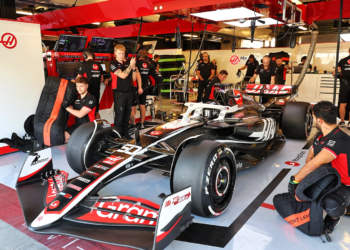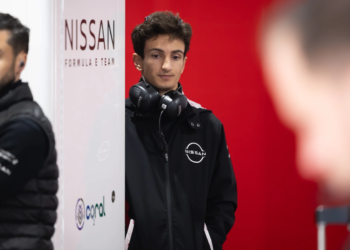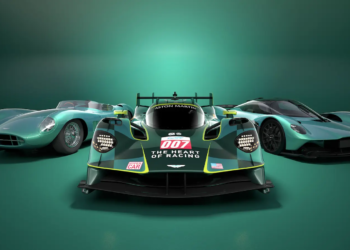Well where do we start? The Spanish Grand Prix will forever be remembered by fans and members of the paddock alike for several reasons.
Not only did Mercedes drivers’ Nico Rosberg and Lewis Hamilton suffer their biggest coming together on the opening lap, forcing both drivers into retirement on the spot, but Dutch teenager Max Verstappen stormed to his first victory in his first race for Red Bull.
The 66-lap race was thrilling from the word go, with a sense of nostalgia throughout as the battle for supremacy was fought over between four drivers, all of whom appeared in the same screenshot on several occasions.
With the motorsport world still in raptures after Verstappen’s unforgettable rise to victory, Grand Prix Times’ Andy Young looks at five talking points from an unbelievable afternoon of action.
1. What now for Mercedes after an embarrassing Spanish GP?

After locking-out the front row of the grid once again, many were looking forward to a duel for victory between Rosberg and Hamilton.
Although Hamilton secured pole position for the third time this season, Rosberg shot around the outside of the Briton into the lead at Turn 1.
On the run down to Turn 4, however, Hamilton managed to close the gap to his team-mate at a phenomenal rate after Rosberg mistakingly selected the wrong engine mode.
In his desperate attempt to maintain his lead, the German aggressively defended his position. Due to the massive speed difference between the two, Hamilton was forced onto the grass, losing control of his car and spearing into the rear of his team-mate.
Although the race stewards elected against penalising either driver, the paddock and motorsport world as a whole were divided as to who was at fault.
Regardless of who’s fault the resultant collision was, the future implications could be dramatic for the German marque.
For several seasons they have prided themselves over allowing their drivers to race for track position, with races such as the 2014 Bahrain GP standing out as a classic example.
Admittedly they have made contact before – at the 2014 Belgian GP – but nothing near the scale of their collision in Spain.
Both cars were forced into retirement on the spot, and the collision gifted their rivals a victory in the process.
Whether you blame Rosberg for his aggressive defending or Hamilton for his aggressive attacking, there’s no denying that the team could well consider enforcing team orders in the future in a bid to guarantee both cars finishing first and second.
It’s happened before at other teams, most notably at McLaren in 1998 when Mika Hakkinen and David Coulthard agreed before the season-opener in Australia that whoever reached Turn 1 in the lead would win the race.
That’s why Coulthard was forced to allow Hakkinen through during the closing stages of the race after the Finn made an unscheduled call into the pits.
While Mercedes will have to decide whether to allow their drivers to race for position in the future, there’s also no denying that the relationship between Rosberg and Hamilton could well have reached a point of no return.
Admittedly the duo have fallen out before, but as stated above they have yet to collide in such a spectacular and embarrassing fashion.
Although rumours are rife that Rosberg will stay with Mercedes for 2017, the question now being asked is can Hamilton and Rosberg remain a productive partnership?
Naturally such decisions are months away from being decided upon, but such embarrassment certainly sows the seeds of doubt and any repeat of such misdemeanours will certainly make the team think twice about their current partnership.
2. More to come from Verstappen

Although many might be quick to remind people that Verstappen’s maiden victory in Formula 1 came after the fastest two cars were eliminated at the start, there is absolutely no question that the Dutchman is a future force to be reckoned with.
Admittedly victory in Barcelona would’ve been exceptionally difficult had Hamilton and Rosberg not tangled at Turn 4, however with Renault still set to introduce an engine upgrade later in the season, Verstappen could well find himself on the top spot of the rostrum again before the end of the year.
Last season Mercedes were beaten on outright pace at Malaysia, Hungary and Singapore, prime examples that the German marque weren’t necessarily dominant at each race.
With Ferrari still struggling to fully assert themselves as a clear second behind Mercedes in the pecking order, Red Bull will certainly fancy themselves should Mercedes find themselves second best.
Although Verstappen has a multiple race winner as a team-mate in the form of Daniel Ricciardo, it’s been made abundantly clear that the Dutchman is no stranger to both producing blistering quick lap times and preserving his tyres while defending from the likes of Kimi Raikkonen.
So Verstappen’s victory in Spain was by no means a fluke. The teenager will only get stronger as he continues to battle at the front, securing front-row starts and finishing on the podium.
Should Red Bull produce a car capable of championship supremacy in 2017 or 2018, then Verstappen will certainly find himself the prime candidate to lead the team back to their former glory.
However, with Ricciardo also more than capable of holding his own at the sharp end of the order, Red Bull could find themselves in familiar waters, especially given Verstappen’s vocal outbursts at Toro Rosso earlier in the season.
3. Is Vettel feeling the pressure at Ferrari?

For three consecutive races Vettel has vented his frustration either off track or via team radio, with his frustrations reaching boiling point in Sochi after being clouted by Daniil Kvyat on two occasions at the start of the race.
Beforehand he voiced his disapproval of Kvyat’s antics at the start of the Chinese GP, where the Russian racer stormed up the inside of the German at Turn 1. This in turn forced Vettel to take avoiding action, which saw him hit team-mate Raikkonen on the outside.
After the race Vettel remained in a disapproving mood, despite finishing on the podium, lambasting Kvyat in person prior to the podium celebrations.
In Spain Vettel was at it again, this time via the team radio as former team-mate Ricciardo stormed up the inside at Turn 1 during the closing stages of the race.
“If I don't avoid that, he's just going straight to my car!" exclaimed Vettel. "Honestly, what are we doing? Racing or ping-pong?”
Naturally Vettel’s recent run of whining over team radio has been far from popular amongst the fans, who view the German’s outbursts as those from a once-dominant world champion who is now fighting for his place at the top.
Although that’s certainly not the case, Ferrari as a whole definitely under severe pressure, especially after team president Sergio Marchionne’s presence at several races of late.
Prior to the Spanish GP Marchionne stated that he expected Ferrari to start winning, and after the Mercedes slip-up on the opening lap, a golden opportunity was wasted.
In fact in the hybrid era Red Bull has won more races than Ferrari, with the Scuderia still unable to secure a victory so far this season.
For Vettel bad luck has been a major factor in his lack of decent results so far.
Team-mate Raikkonen has managed to nail down three podium finishes including two second places, leaving him second in the championship and 13 points clear of Vettel.
4. Carlos Sainz sends out a reminder

During the two weeks between the Russian and Spanish GP’s, Verstappen, Kvyat and Red Bull dominated the headlines, leaving Carlos Sainz practically in the shadows.
So what better response from the Spaniard on home soil than to out-qualify new team-mate and former Red Bull driver Kvyat by just under a second, progressing through to Q3 in the process whilst Kvyat was eliminated in Q2.
During the race Sainz catapulted from eighth to third on the opening lap, making the most of the Mercedes incident and a minor mistake from Vettel at Turn 3.
Once the race resumed Sainz held his position for several laps ahead of Vettel and Raikkonen, before eventually losing track position to the much more experienced Ferrari drivers.
Although Sainz lost ground as the race wore on he still managed to finish proceedings sixth and well within the points, flying the Spanish flag high on home soil.
Meanwhile Kvyat could only manage one point in tenth, albeit after producing the fastest lap in the process.
With Verstappen now more than settled into his position at Red Bull alongside Ricciardo, Sainz’s chances of immediate progression within the Red Bull family look exceptionally thin.
However, his career could certainly blossom outside of Red Bull should he join another team altogether.
5. Should F1 adopt IndyCar’s blue flag ruling?

During the race several drivers were shown blue flags, albeit with the ‘faster’ drivers on the lead lap quite a distance away and clearly not producing blistering lap times.
For many years the blue flag rule has been debated at great length, with both Tony Fernandes and Richard Branson both calling for them to be abolished during their time in the sport.
After all they fail to assist the sport in producing exciting racing, as they force drivers within the midfield racing nose-to-tail to slow down and allow so-called ‘faster’ drivers through.
In Spain last weekend both Jenson Button and Jolyon Palmer were at the brunt of the blue flag rule, with the latter even being informed by his team about Ricciardo behind.
"OK Jo, we have solid blue for Ricciardo behind,” explained Palmer’s race engineer, Julien Simon Chautemps. “He is the race leader, two seconds behind.”
"Can barely see him in the mirrors!" Palmer responded.
Further up the road Button found himself in a tricky situation whilst battling for the last few points-paying positions, with Ricciardo and Vettel closing in on the Briton with Kvyat in the Toro Rosso close behind the duo.
If Button had slowed to allow Vettel and Ricciardo through then the loss of momentum would naturally have allowed Kvyat to overtake him as well, or at least close the gap significantly.
With the blue flag rule proving extremely costly to midfield battles – such as Button’s in Spain – why doesn’t F1 adopt IndyCar’s blue flag ruling.
In IndyCar a driver can fight to remain on the lead lap, treating the car behind as if it is for track position.
However once lapped the driver must then adhere to the traditional blue flag rulings as before.
Such a predicament was witnessed at the Grand Prix of Alabama earlier in the season, when Simon Pagenaud came up behind Sebastian Bourdais with Graham Rahal hot on his heels.
Adopting this ruling would enable drivers to focus on their battle for track position, and after all if the driver is preparing to lap another car he should be quicker anyway.






